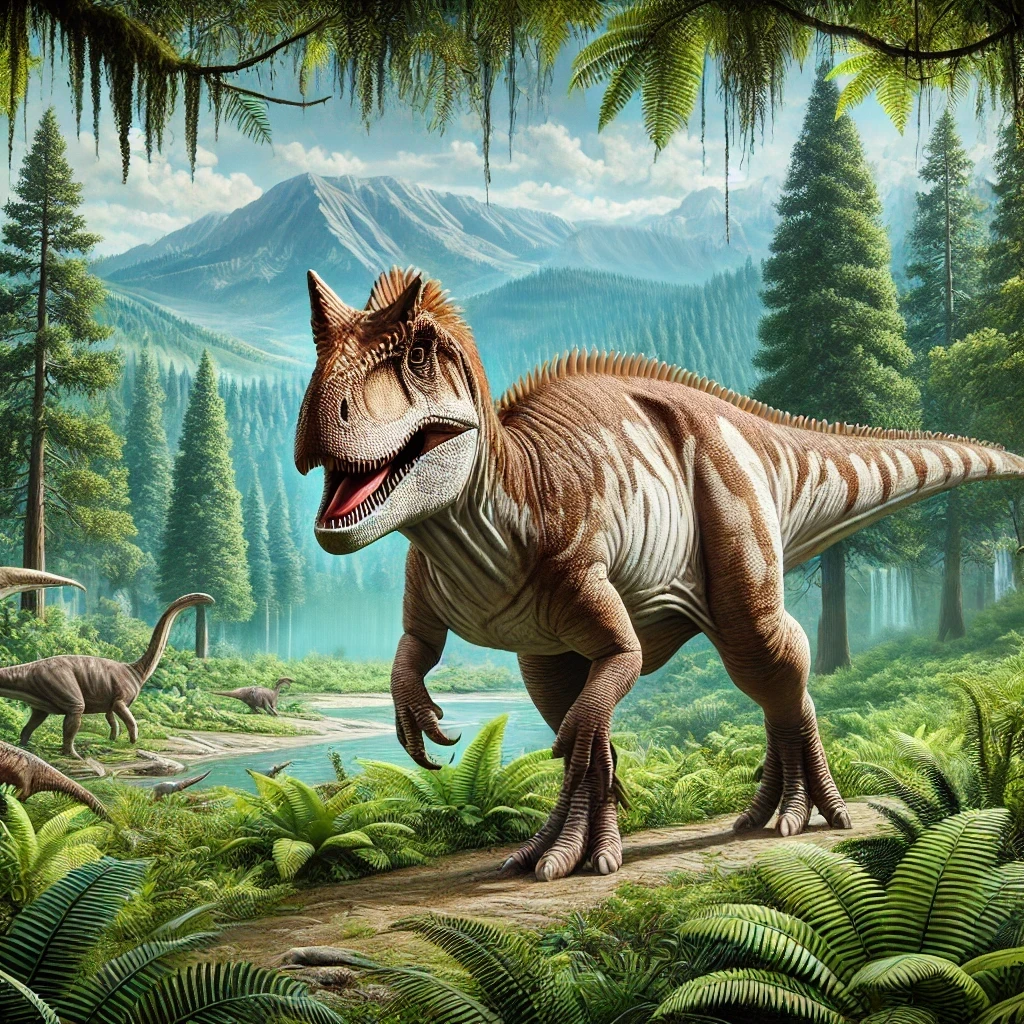Ceratosaurus
Pronunciation:
Seh-rah-toh-sore-us
Name Meaning:
“Horned lizard”
Dinosaur Classification:
- Kingdom: Animalia
- Phylum: Chordata
- Class: Reptilia
- Order: Saurischia
- Suborder: Theropoda
- Family: Ceratosauridae
- Genus: Ceratosaurus
- Species: C. nasicornis
Dinosaur Description:
Ceratosaurus was a medium-sized theropod dinosaur that roamed North America, Europe, and possibly Africa during the Late Jurassic period, around 150 million years ago. It is easily recognizable by the prominent horn on its snout, which is where it gets its name, “horned lizard.” This horn, along with smaller ones above its eyes, set Ceratosaurus apart from other theropods of its time.
The body of Ceratosaurus was built for both speed and power. It had strong, muscular hind legs, a long tail for balance, and relatively short arms. Unlike some of its contemporaries, such as Allosaurus, Ceratosaurus had a row of osteoderms (bony plates) along its back, giving it a somewhat armored appearance. These features, along with its distinctive horns, suggest that Ceratosaurus was not only a predator but also likely engaged in displays or combat with rivals or potential mates.
Ceratosaurus reached lengths of up to 20 feet (6 meters), making it smaller than some of the larger predators of the Jurassic. However, its size, combined with sharp, serrated teeth and powerful jaws, made it a formidable hunter. It likely preyed on smaller dinosaurs, aquatic animals such as fish, and even scavenged when opportunities arose. The discovery of its fossils in areas that were once riverbeds suggests that Ceratosaurus may have spent a significant amount of time hunting near water sources.
The horns on its head have been the subject of much debate. Some scientists believe they were used for display purposes, to attract mates or to intimidate rivals. Others suggest they may have been used in combat, though the relatively fragile structure of the horns indicates they were not primarily for fighting.
Dinosaur Diet and Behavior:
Ceratosaurus was a carnivore, likely preying on smaller dinosaurs and aquatic creatures like fish and crocodiles. Its diet was diverse, and it may have been an opportunistic predator, feeding on whatever prey was available. Fossil evidence suggests that it lived in both forested areas and near water sources, making it an adaptable and versatile hunter.
Dinosaur Size:
Ceratosaurus reached lengths of about 20 feet (6 meters), with a height of approximately 8 feet (2.5 meters) at the hips.
Dinosaur Weight:
Estimates suggest Ceratosaurus weighed between 1 and 2 tons (2,000 to 4,000 lbs).
Fossil Discoveries:
The first Ceratosaurus fossils were discovered in the late 19th century in North America, with significant findings coming from the Morrison Formation in Utah. The discovery was made by Othniel Charles Marsh in 1884, during the famous Bone Wars. Since then, additional fossils have been found in Portugal and Tanzania, indicating that Ceratosaurus had a wide geographic range. The original fossil was nearly complete, allowing paleontologists to gain a detailed understanding of the species’ anatomy.
What Period Did The Dinosaur Live:
Ceratosaurus lived during the Late Jurassic period, approximately 153 to 148 million years ago.
Notable Facts or Trivia:
– Ceratosaurus had a distinct horn on its snout, unlike most other theropods of the time.
– It had bony armor along its back, making it somewhat unique among theropods.
– Ceratosaurus lived alongside larger predators like Allosaurus but likely filled a different ecological niche.
– Its fossils have been found on multiple continents, including North America, Europe, and possibly Africa.
Scientific Significance:
Ceratosaurus has contributed to the understanding of theropod diversity during the Jurassic period. Its unique characteristics, such as the nasal horn and osteoderms, suggest that even within the group of large carnivorous dinosaurs, there was a wide range of physical traits and behaviors. Additionally, its presence in multiple continents indicates a broader geographic distribution of certain dinosaur species during this time.
Extinction & Legacy:
Ceratosaurus went extinct by the end of the Jurassic period, likely due to environmental changes and competition with other large predators. However, it remains an important dinosaur in paleontology, particularly because of its unique features and wide range of fossil discoveries. Its distinctive appearance makes it one of the more easily recognizable dinosaurs, and it has been featured in various documentaries and media, contributing to its legacy in popular culture.

